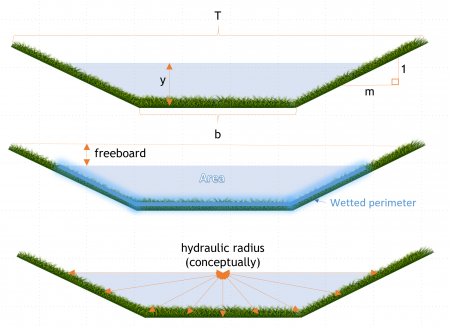Flow in a swale
Jump to navigation
Jump to search
The printable version is no longer supported and may have rendering errors. Please update your browser bookmarks and please use the default browser print function instead.

Where:
- Q = the flow in the swale (m3/s)
- A = the cross sectional area of the swale (m2)
- P = the wetted perimeter of the swale (m)
- S = the longitudinal slope (m/m)
- n = Manning's coefficient or 'Manning's n' (dimensionless)
| n value range | Good condition turf grass | Other |
|---|---|---|
| 0.002 - 0.010 | Where the average depth of flow is at ≥ 2 times the height of the vegetation | Supple tree seedlings such as willow or cottonwood growing where the average depth of flow is at ≥ 3 times the height of the vegetation |
| 0.010 - 0.025 | Where the average depth of flow is between 1 - 2 times the height of the vegetation | Moderately dense weeds, or tree seedlings growing where the average depth of flow is from 2 -3 times the height of the vegetation |
| 0.025 - 0.050 | Where the average depth of flow is about equal to the height of the vegetation | 8- to 10-year-old willow or cottonwood trees inter-grown with some weeds and brush (none of the vegetation in foliage) |
| 0.050 - 0.100 | Where the average depth of flow is < 0.5 times height of the vegetation | bushy willow trees about 1 year old inter-grown with weeds along side slopes (all vegetation in full foliage) |
References[edit]
- ↑ Arcement, G.J., Schneider, R. Guide for Selecting Manning's Roughness Coefficients for Natural Channels and Flood Plains U.S.G.S. WATER-SUPPLY PAPER 2339, 1989 https://pubs.usgs.gov/wsp/2339/report.pdf

